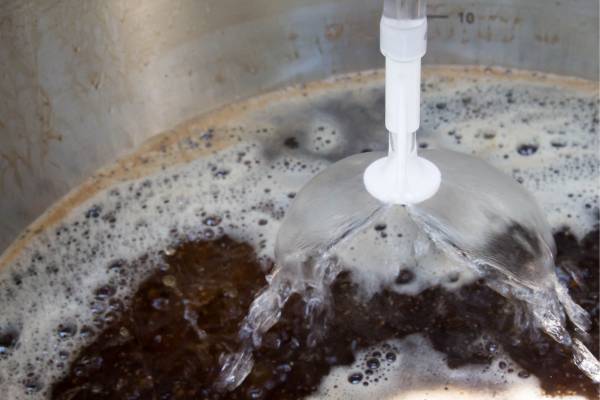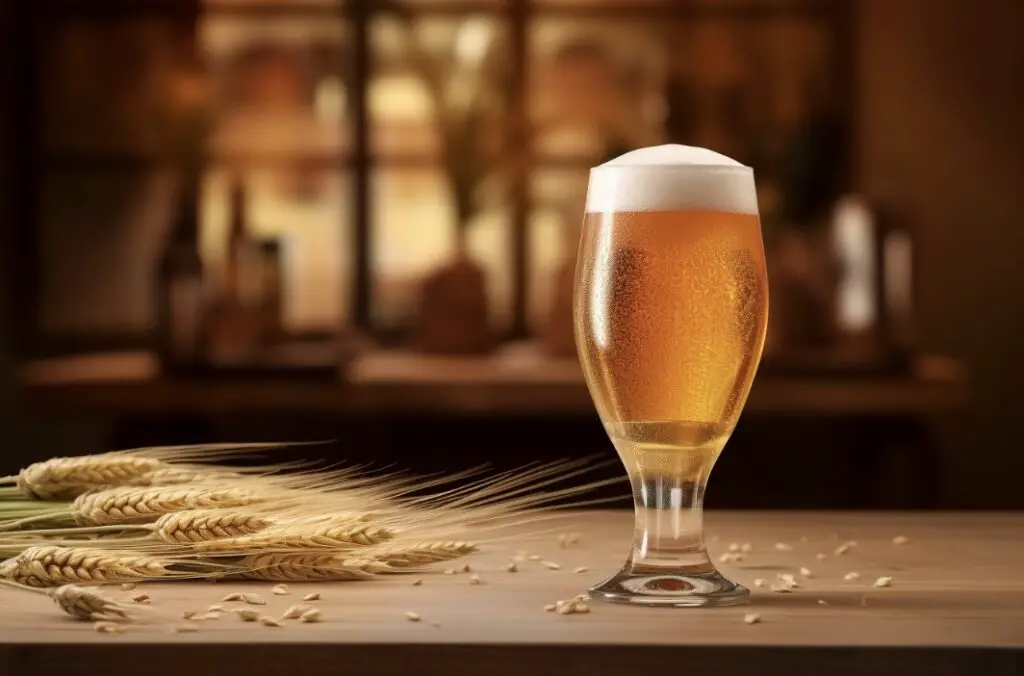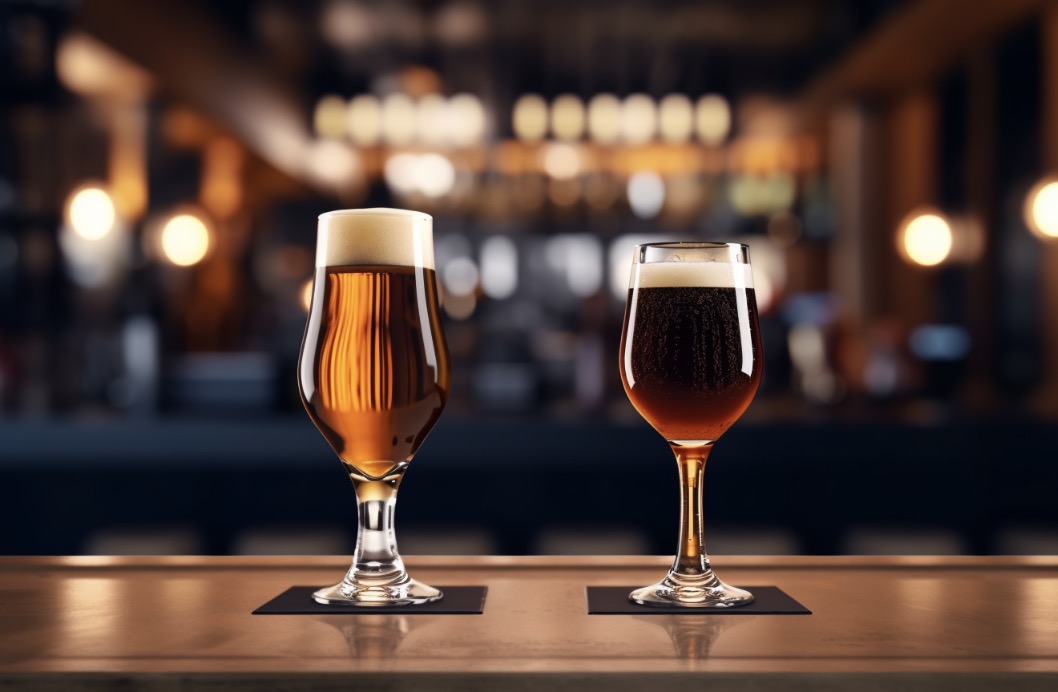In recent years, non-alcoholic beer has taken the beverage industry by storm, with a staggering market worth predicted to exceed $26 billion by 2026. Thanks to innovative brewing techniques and passionate craft brewers, these alcohol-free alternatives offer bold flavor profiles without compromising your sobriety.
But have you ever wondered how non-alcoholic beer is made, both industrially and in the comfort of your own home? Join us as we dive into the world of non-alcoholic brewing to learn about its fascinating process, benefits, and various methods that bring this great-tasting alternative to life.
Key Takeaways
- Non-alcoholic beer contains less than 0.5% ABV and can be made through restricted fermentation, alcohol removal techniques or dilution.
- Industrial methods of non-alcoholic brewing involves Malting and Milling, Mashing and Boiling, as well as various Alcohol Removal Methods like Vacuum Distillation or Boiling.
- Making non-alcoholic beer at home requires basic equipment such as a brewing kit, water, malt extract, hops, yeast and flavor enhancers (optional). The process includes sanitizing equipment, boiling wort with yeast to start fermentation before removing any remaining alcohol using different methods such as boiling off the alcohol or reverse osmosis.
- Popular Alcohol Removal Methods used in homebrewing include Boiling off method; Reverse Osmosis; Vacuum distillation; Dialysis which all have their advantages and downsides that should be carefully considered.
Non-alcoholic beer refers to beer that has less than 0.5% ABV, which is achieved through various brewing methods such as restricted fermentation, alcohol removal techniques, or dilution.
What Exactly Is Non-Alcoholic Beer?
Non-alcoholic beer, often referred to as NA beer or alcohol-free beer, is a type of beverage that contains little to no alcohol content. Typically, non-alcoholic beers have less than 0.5% Alcohol by Volume (ABV), which distinguishes them from traditional beers that usually contain around 4-6% ABV or more.
The rise in popularity of non-alcoholic beers can be attributed to various factors such as health concerns, religious beliefs, and designated driving duties. With advancements in brewing methods and an increasing focus on low-alcohol alternatives by craft brewers, today’s non-alcoholic beers offer a wide range of flavors and styles that cater to diverse preferences without sacrificing taste or quality.
Benefits Of Non-Alcoholic Beer
Non-alcoholic beer has gained popularity in recent years due to its numerous benefits, including:
1. Hydration: Non-alcoholic beer can help with hydration due to its high water content.
2. Recovery: Some studies suggest that non-alcoholic beer may aid in muscle recovery after exercise due to its carbohydrate and electrolyte content.
3. Healthier Alternative: Non-alcoholic beer contains fewer calories and may be a healthier alternative to traditional beer for those watching their weight or trying to stay sober.
4. Improved Sleep: The hops in non-alcoholic beer have a calming effect and may help improve sleep quality.
5. Safe for Pregnant Women: Non-alcoholic beer is safe for pregnant women who still want to enjoy the taste of beer without the risk of alcohol consumption.
6. Religious Beliefs: Non-alcoholic beer is a great option for individuals following religious beliefs that prohibit the consumption of alcohol.
7. Designated Driving: Non-alcoholic beer allows designated drivers to still enjoy a drink without the risks associated with drinking alcohol.
Industrial Methods Of Non-Alcoholic Beer Brewing
Discover the advanced techniques and processes involved in making non-alcoholic beer on an industrial scale, including malting and milling, mashing and boiling, and alcohol removal methods like vacuum distillation or boiling.
Techniques For Removing Or Restricting Alcohol Formation
There are various techniques used during Non-Alcoholic beer brewing to remove or restrict alcohol formation. Here are a few:
1. Controlled Fermentation: By carefully controlling the fermentation process, brewers can limit the amount of alcohol produced in their beer. This is done by regulating temperature and yeast strains.
2. Dealcoholization: This involves using various methods to remove alcohol from already brewed beer. The most popular method is vacuum distillation, where the beer is heated under low pressure, causing the alcohol to evaporate and be collected separately.
3. Dilution: Brewers can dilute their high ABV beer with water or another non-alcoholic beverage to create a lower ABV drink. This is common in some European countries where low-alcohol beer is popular.
4. Simulated Fermentation: Using this technique, brewers can simulate fermentation without actually producing significant levels of alcohol. This involves using yeast strains that cannot produce ethanol.

By utilizing these techniques during Non-Alcoholic beer brewing, brewers can create beverages with reduced or no alcohol content while still retaining the flavor profile of traditional beers.
Malting And Milling
Malting and milling are crucial steps in the brewing process of non-alcoholic beer. Malting is the process of germinating the barley grains, followed by a drying process that halts germination.
This results in breaking down complex starches into simpler sugars that can be converted to alcohol during fermentation.
Milling involves crushing malted barley into smaller particles to maximize its surface area exposed to hot water during mashing. The fine grind also helps release enzymes responsible for converting starches into fermentable sugars during mashing.
Mashing And Boiling
During the mashing stage of non-alcoholic beer production, grains such as barley are steeped in hot water to extract their sugars. This process leads to the creation of a sweet liquid called wort that is essential for brewing beer.
The wort is then boiled with hops and other flavorings to create a distinct taste profile for the final product.
In order to remove or restrict alcohol formation during this process, brewers may use techniques like high-temperature mashing or include additional enzymes to break down sugars fully.
Mashing and boiling play an essential role in creating a full-bodied, flavorful non-alcoholic beer without compromising on quality or taste.
Alcohol Removal Methods Like Vacuum Distillation Or Boiling
There are several methods to remove alcohol from beer, and two of the most popular ones are vacuum distillation and boiling. Here is some information on each of these methods:
– Vacuum Distillation: This method uses a vacuum to lower the boiling point of alcohol, allowing it to be removed at a lower temperature than usual. The beer is heated in a vacuum chamber, where the alcohol evaporates and can be collected separately. This is a common method used by commercial breweries to create non-alcoholic beer.
– Boiling: Boiling off the alcohol involves heating the beer until the alcohol evaporates and boils away. Homebrewers often use this method since it doesn’t require any special equipment. However, this method can also affect the taste of the beer since it changes its chemical composition.
Both vacuum distillation and boiling have their advantages and disadvantages when it comes to alcohol removal in beer. While vacuum distillation results in less flavor changes, it requires specialized equipment that might be too expensive for homebrewers. On the other hand, boiling is simple but has risks that include burning or scorching as well as significant loss in taste quality.
– Creating a quality Non Alcoholic beer is not easy, and there are three common production methods: vacuum distillation, reverse osmosis, and dialysis.
– Craft brewers are proving that non-alcoholic beer can boast big flavor.
– The production of alcohol is an important aspect of fermenting any beverage.
Making Non-Alcoholic Beer At Home
For those interested in making non-alcoholic beer at home, the basic brewing process involves preparing ingredients and equipment, mashing and boiling wort with yeast like traditional beer, followed by an alcohol removal method such as boiling off or using a reverse osmosis kit.

Ingredients And Equipment Needed
To make non-alcoholic beer at home, you will need a few basic brewing supplies and ingredients. Here’s what you’ll need:
1. Brewing Kit: Purchase a basic homebrew kit that includes a fermenter, airlock, thermometer, hydrometer, bottling bucket, bottles, caps and priming sugar.
2. Water: Non-alcoholic beer requires clean and filtered water to achieve the right flavor profile.
3. Malt Extract: Liquid malt extract is used to create the wort (unfermented beer) which provides the foundation for your non-alcoholic beer.
4. Hops: Add bittering and aroma hops to balance out the sweetness of the malt extract and provide the desired flavor profile of your beer.
5. Yeast: Choose a yeast strain that will help create a desirable flavor when combined with your chosen ingredients.
6. Flavor Enhancers (Optional): Additives like fruit concentrate or spices can enhance the taste of your non-alcoholic beer.
7. Alcohol Removal Techniques: Various alcohol removal methods such as boiling off or vacuum distillation can be used depending on preference.
With these ingredients and equipment in hand, you are ready to start brewing non-alcoholic beer from scratch!
Basic Brewing Process
To make non-alcoholic beer at home, you’ll need a few basic tools and ingredients. Here’s a breakdown of the brewing process:
1. Gather your ingredients: You’ll need things like malt extract, hops, yeast, and water. You can also add other ingredients like spices or fruit for added flavor.
2. Sanitize your equipment: It’s important to sanitize all of your brewing equipment to prevent any unwanted bacteria from contaminating your brew.
3. Boil your wort: Combine the malt extract and hops in water and bring it to a boil. This creates what’s known as “wort,” which is essentially the liquid base of your beer.
4. Add yeast: Once the wort has cooled down, add in some yeast to start the fermentation process. The yeast will consume the sugars in the wort and turn it into alcohol.
5. Wait for fermentation to complete: Depending on the type of yeast you use and the temperature of your brew, fermentation can take anywhere from a few days to a couple of weeks.
6. Remove alcohol (optional): If you want to make sure your beer is truly non-alcoholic, you’ll need to remove the alcohol that was created during fermentation. There are several methods for doing this, including boiling off the alcohol or using specialized equipment like a vacuum distiller.
7. Carbonate: Once you’ve removed any remaining alcohol (if desired), you can carbonate your beer by adding sugar and bottling it up for a couple of days.
By following these steps, you can create a delicious batch of non-alcoholic beer right in your own home! And with more people interested in low-alcohol options these days, it’s never been easier or more rewarding to try brewing some yourself.
Alcohol Removal Methods For Homebrewers
Reducing the alcohol content for non-alcoholic beer can be done using several different methods. Here are some of the most popular alcohol removal methods that homebrewers use:
1. Boiling off method: This involves simply boiling the beer for a specific period, which causes the alcohol to evaporate out of the brew.
2. Reverse osmosis: A more high-tech option, this involves passing brewed beer through a membrane that separates alcohol and water molecules, resulting in a lower-alcohol product.
3. Vacuum distillation: Using heat and pressure in tandem, this method separates beer’s alcohol from water, producing a non-alcoholic brew with a better flavor than other methods.
4. Dialysis: In this process, brewers use a machine that filters out alcohol from their fermented batch.
It should be noted that while these methods do remove some or all of the alcohol from your beer, it may also affect its flavor and overall quality. Therefore, it is important to experiment with each method before settling on one or even combine them.
Tips And Tricks For Making Great Non-Alcoholic Beer
If you want to make great non-alcoholic beer, here are some tips and tricks for you:
1. Choose the right yeast strain: The yeast strain you choose can affect the flavor profile of your non-alcoholic beer. Some yeast strains work better than others in producing low alcohol or no alcohol beers.
2. Use high-quality ingredients: Use fresh and high-quality ingredients such as malted barley, hops, and yeast to improve the taste and aroma of your non-alcoholic beer.
3. Experiment with different flavors: Consider experimenting with different flavors by adding fruits or spices during the brewing process to enhance the taste profile of your non-alcoholic beer.
4. Pay attention to fermentation temperature: The temperature at which you ferment your non-alcoholic beer can have a significant impact on its flavor. Keep a consistent fermentation temperature to achieve desired results.
5. Don’t rush the process: Non-alcoholic beer takes longer to brew than traditional beer because it requires extra steps in removing or restricting alcohol formation. Be patient and don’t rush the process.
6. Practice good sanitation habits: Ensure that all equipment used for brewing is properly sanitized before use to prevent contamination from bacteria and other microorganisms.
7. Try different alcohol removal methods: There are several ways to remove alcohol from brewed beer such as vacuum distillation, reverse osmosis, and dialysis. Try different methods until you find one that works best for you.
By following these tips and tricks, you can produce a delicious non-alcoholic beer that rivals traditional beers in taste and quality while remaining low in alcohol content.
Variants Of Non-Alcoholic Beer
Non-alcoholic beer comes in many different forms, including low alcohol beer, flavored non-alcoholic beer, and gluten-free non-alcoholic beer.
Low Alcohol Beer (<0.5% ABV)
Low alcohol beer, also known as light beer or non-intoxicating beer, is a type of non-alcoholic brew that contains less than 0.5% alcohol by volume (ABV). These beers are often brewed using traditional methods with the same ingredients as regular beer, including water, barley, hops and yeast.
Low alcohol beers are popular with those looking to reduce their intake of alcoholic beverages for health reasons or personal preference without giving up the taste and enjoyment of a cold brew.
They offer a refreshing alternative to full-strength beers while providing hydration and fewer calories per serving. Additionally, some people who simply enjoy the taste but want to avoid impairing effects opt for low-alcohol varieties.
Flavored Non-Alcoholic Beer
Flavored non-alcoholic beer is gaining popularity in the market due to its unique and refreshing taste. Breweries are experimenting with various flavors such as ginger, lemon, grapefruit, and even chocolate to cater to different palates.
Flavored NA beers can be made using natural ingredients or artificial flavorings. For example, some breweries add fruit concentrates during the brewing process while others infuse their beer with natural extracts for subtle flavors.
Craft brewers are taking it one step further by creating unique flavor profiles that rival their alcoholic counterparts. Athletic Brewing Company has developed an IPA-inspired brew named “Run Wild” that contains zero alcohol but still packs a hoppy punch.
Similarly, BrewDog’s “Nanny State” offers rich maltiness with notes of coffee and caramel – a great alternative for those who prefer darker beers without alcohol content.
Gluten-Free Non-Alcoholic Beer
Gluten-free diets have become increasingly popular in recent years, leading to a rise in demand for gluten-free products, including non-alcoholic beer. Gluten is a protein found in grains such as barley and wheat that can cause health problems for individuals with celiac disease or gluten intolerance.

One example of such a product is Omission Brewing Company’s Ultimate Light Golden Ale. This beer is not only alcohol-free but also brewed with malted barley that has had the gluten removed through proprietary brewing processes.
Health Benefits And Risks Of Non-Alcoholic Beer
Non-alcoholic beer offers benefits such as hydration and recovery for athletes, but there are also risks associated with excessive consumption.
Benefits Like Hydration And Recovery
Non-alcoholic beer offers a range of benefits for those who love the taste of beer but want to avoid the effects of alcohol. Here are some of the hydration and recovery benefits:
– Hydration: Non-alcoholic beer can be a great choice for hydration after exercise or other physical activities. It contains water, electrolytes, and carbohydrates that help to rehydrate your body and replenish nutrients lost during exercise.
– Recovery: For athletes and fitness enthusiasts, non-alcoholic beer can also aid in post-workout recovery. The polyphenols in beer, which are compounds found in plants that have antioxidant properties, can help reduce inflammation and muscle damage caused by exercise.
– Low Calorie: Compared to traditional beers, non-alcoholic options contain fewer calories which make it an ideal choice for those on a low-calorie diet.
– Safe to Drink Before Driving: One of the most significant advantages of non-alcoholic beer is that you can enjoy it before getting behind the wheel without any adverse effect on your driving skills or testing positive for alcohol consumption.
– Suitable for Pregnant Women: Non-alcoholic beer is safe for pregnant women as it doesn’t contain any alcohol. It can be a good way for them to enjoy the taste of beer without compromising their health or that of their baby.
Overall non-alcoholic beers offer an excellent alternative to traditional alcoholic beverages with several notable benefits.
Risks Of Consuming Non-Alcoholic Beer
Although non-alcoholic beer is generally considered safe for consumption, there are still certain risks associated with its consumption. Here are some of the risks of consuming non-alcoholic beer:
1. Increased Caloric Intake: Non-alcoholic beer may contain fewer calories than regular beer, but it can still contribute to weight gain if consumed in excess.
2. Dehydration: Like any other alcoholic or non-alcoholic beverage, excessive consumption of non-alcoholic beer can lead to dehydration.
3. False Sense of Sobriety: Consuming too much non-alcoholic beer may give a false sense of sobriety and impair judgment, which can lead to accidents or risky behavior.
4. Health Risks for Certain Individuals: Some people may experience adverse health effects from consuming even small amounts of alcohol, and should avoid drinking non-alcoholic beer altogether. This includes pregnant women, people with liver disease, and those taking certain medications.
5. Possible Exposure to Trace Amounts of Alcohol: Despite being labeled as “non-alcoholic”, some types of non-alcoholic beer may contain trace amounts of alcohol due to the brewing process and other factors.
It’s important to always drink in moderation and be aware of the potential risks associated with any type of beverage, including non-alcoholic beer.
Conclusion
Non-alcoholic beer is gaining more popularity every day, thanks to its health benefits and market demand. Whether produced industrially or at home, the process of making non-alcoholic beer can be quite complex.
From malting and milling to mashing and boiling, each step in the brewing process requires careful attention to detail. With various alcohol removal methods available such as vacuum distillation or boiling off, there are several ways for producers and homebrewers alike to create delicious non-alcoholic brews.
FAQs:
What is the process for making non-alcoholic beer industrially?
The industrial process for making non-alcoholic beer involves brewing regular beer and then removing the alcohol through a variety of methods such as vacuum distillation or reverse osmosis. Once the alcohol has been removed, flavors and carbonation are added to create a drink that tastes like traditional beer but with less than 0.5% alcohol content.
How can I make non-alcoholic beer at home?
There are several ways to make non-alcoholic beer at home, including using commercial kits or brewing your own recipe while controlling the fermentation time and temperature to limit alcohol production before stopping it altogether with pasteurization.
Is there a difference in taste between alcoholic and non-alcoholic beers?
Non-alcoholic beers may have slightly different flavor profiles compared to their alcoholic counterparts due to differences in ingredients used, processing techniques, and the removal of alcohol itself.
Why would someone choose to drink non-alcoholic beer?
People often choose non-alcoholic beers for various reasons such as reducing their overall consumption of alcohol, religious or cultural restrictions on drinking, health concerns related to alcohol consumption, pregnancy or other medical conditions that might be made worse by consuming even small amounts of alcohol




